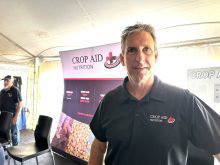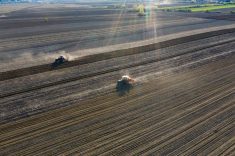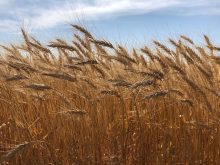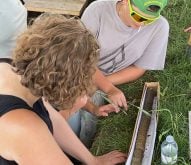When discussing the nutrient needs of a farming operation, most producers tend to think first about the macronutrients that are applied in large quantities to fields.
These macronutrients, which include elements such as nitrogen, phosphorus, potassium and sulphur, are essential but only one part of a well-balanced field.
There is a second category of nutrients called micronutrients that are also extremely important for plant growth and success.
Read Also

Claas brings 1000 Series SP forage harvesters to Canada
In mid-August, Claas unveiled its new line of Jaguar forage harvesters at an event in Visalia, California, deep in the heart of that state’s dairy region.
According to Jeff Schoenau, a professor of soil science and soil nutrient management chair at the University of Saskatchewan, “Deficiencies of micronutrients will negatively impact our crops just the same as macronutrient deficiencies will. So, we need to be thinking about all nutrients, both micro and macro, when we talk about fertility and plant nutrition.”
Schoenau’s research on micronutrient deficiencies in western Canadian soils has largely focused on the availability of copper, zinc, boron, manganese, iron and chlorine to plants in various soil types.
Micronutrients play key roles in metabolic processes and the physiology of plants. In some cases, such as with copper and chlorine, they can also aid in disease resistance.

Nutrient interactions
Working with both macronutrients and micronutrients is all about finding the correct balance as different nutrients can interact with each other in positive or negative ways. The positive functions of available micronutrients are vast and diverse, but deficiencies can adversely affect a producer’s crops.
Knowing what you are applying and why you are applying it is vital as nutrients can have a wide range of interactions.
Schoenau states one example of a negative micronutrient and macronutrient interaction involves applying a large amount of phosphorus to a field with soils that are marginal or deficient of zinc.
“A large application of phosphorus can induce a rather severe zinc deficiency as the phosphorus can interfere with zinc uptake and mobility in the plant. If your soil test is showing marginal or low zinc and you intend to apply a large amount of phosphorus, then you will need to add some zinc to account for this interaction.
“We need to think about these interactions and make sure we have everything in balance to achieve our best possible outcomes.”

Symptoms easily confused
Micronutrient deficiencies can sometimes be identified through the various symptoms they produce in the plant. For example, copper deficiency often causes a twisting and curling of the leaf tip called pig-tailing (see photo at top), which is especially evident in cereals. Later on, sometimes it is also associated with browning, or melanosis, of the heads and poor grain fill.
Zinc deficiency will often produce a yellowing, or chlorosis, in between veins of the leaves and smaller leaf size.
Other micronutrients have different deficiency symptoms. But physical symptoms do not always tell the whole story.
It is essential to rule out other possible causes of these symptoms, as sometimes the nutrient deficiency can produce similar symptoms as other sources of plant stress.
For example, the wilting appearance in plants that may show up as a result of copper deficiency is easily confused with drought stress.
“Visual symptoms can be a good first clue, but it is important to be aware that there are a lot of other things out there that can produce similar symptoms, so it is essential to confirm your suspicions with a tissue test or a soil test, and ideally running a test strip through the field to verify that there is potential for response to the micronutrient under the conditions on your own farm,” says Schoenau.
Collect evidence
Producers are encouraged to use multiple signs of evidence to establish whether a deficiency exists.
There are several diagnostic tools for measuring deficiencies that may be used in combination. For example, soil tests can be done to look at the available portion of soil micronutrients from specific areas of the field.
“Soil tests are a great tool, but they aren’t always conclusive, as is the case with a lot of tests. For that reason, a tissue test can be a useful tool to use alongside the soil test for micronutrients.
“Finally, a test strip running through a field gives opportunity to see what is going on throughout a larger section of the landscape in regard to the supply of available nutrients and response to fertilization. This increases the reliability of predicting whether or not a positive response to a micronutrient application will be obtained,” says Schoenau.
Micronutrient deficiencies can be directly related to topographical features.
“It will always depend on the micronutrient element and soil and environmental conditions. Position in the landscape can be a strong controlling factor. For example, the knolls are often of a sandier texture and higher pH with free lime that fixes micronutrient metals into less soluble forms, so they would be the first place to look for a deficiency of copper or zinc in a field.

“On the other hand, with chloride, which is highly mobile in the soil with water, we may find the most deficient parts of the fields are the low spots where chloride may be leached below the root zone in spring as a result of the accumulation of snowmelt runoff.”
Soil, topography and water
It really depends on the micronutrient in question, but soil properties, topographic position and water all play a role.
Micronutrient-deficient areas can be areas of different parent material like a sand or gravel lens, or different elevation and surface curvature like knolls, and the extent can vary greatly.
Remote-sensing tools such as satellite and drone imagery along with combine yield maps can be useful indicators of areas that could use some further diagnostics.
Schoenau explains we need to take a precision approach and identify areas where limitations may exist and then make an informed decision about application of any micronutrients recommended for specific areas.
Micronutrient application
Once the diagnostics have been completed, micronutrients can be applied in a variety of ways.
Some micronutrients can be applied at the time of seeding as part of a fertilizer blend. They can be placed inside or outside of the seed row, but producers must be aware of possible toxicity if there is too much placed close to the seed. Application rates that are too high can cause toxicity from some micronutrient elements like boron and copper.
Some micronutrients can be broadcast or incorporated prior to seeding, which is often done in the fall. A foliar application can also be effective to rectify a micronutrient deficiency in the year it is noticed.
With each of these applications it is important to consult with a professional to ensure that rate, timing and possible toxicities are accounted for.
Schoenau says to understand what is going on in his or her fields is essential to a producer’s success.

“I think the return on any type of analytical assessment regarding the ability of the soil to supply nutrients, whether that is a soil test or a tissue test, is a great investment as opposed to just guessing.
“Applying nutrients to a field based on guesses and feeling is not an effective tactic. You want to have the knowledge and understanding of what fields and areas of the field specifically need. If there is a problem area of a field and it isn’t yielding up to snuff, then it is worth your while to take a soil sample from the problem area and the non-problem area for comparison as a kind of forensic assessment.”
Producers try to get the most out of areas of their farms that are historically successful, using approaches like variable-rate fertilizer application to ensure the successful areas continue to be successful.
However, there is an argument to be made about knowing why other parts of your land have been historically less successful.
The more you know about your land and the more informed you are about steps you can take to make difficult sections less of a problem, the better set up you will be to be successful.
“Fertility limitations may be overcome through fertilizers and other amendments containing certain macronutrients and micronutrients, but it may be something totally different such as a dense soil layer or salinity, but if you don’t know what the problem is, you can’t address it.
“There is a fine suite of tools available to farmers now to investigate, document and address a lot of problems,” says Schoenau.















